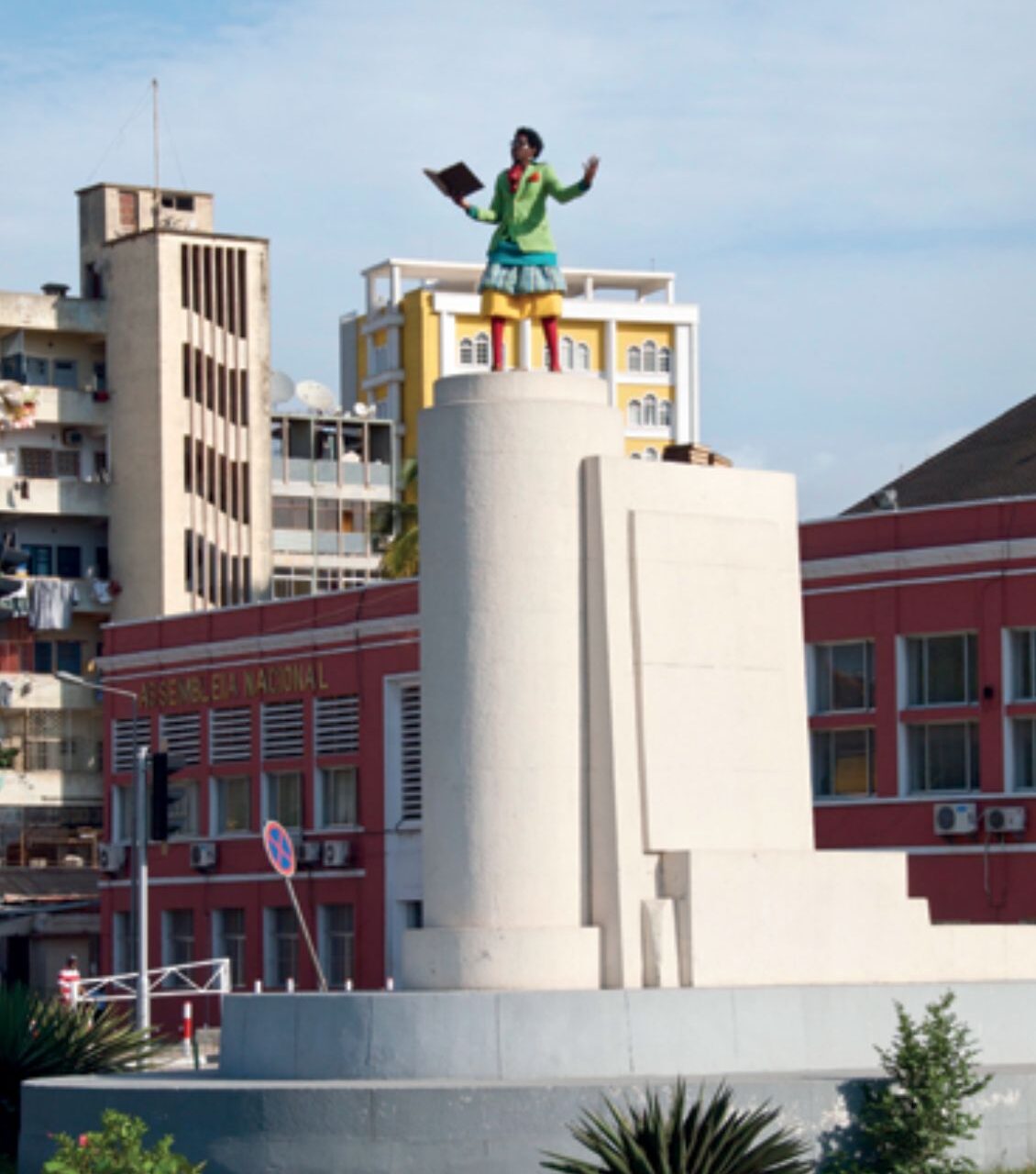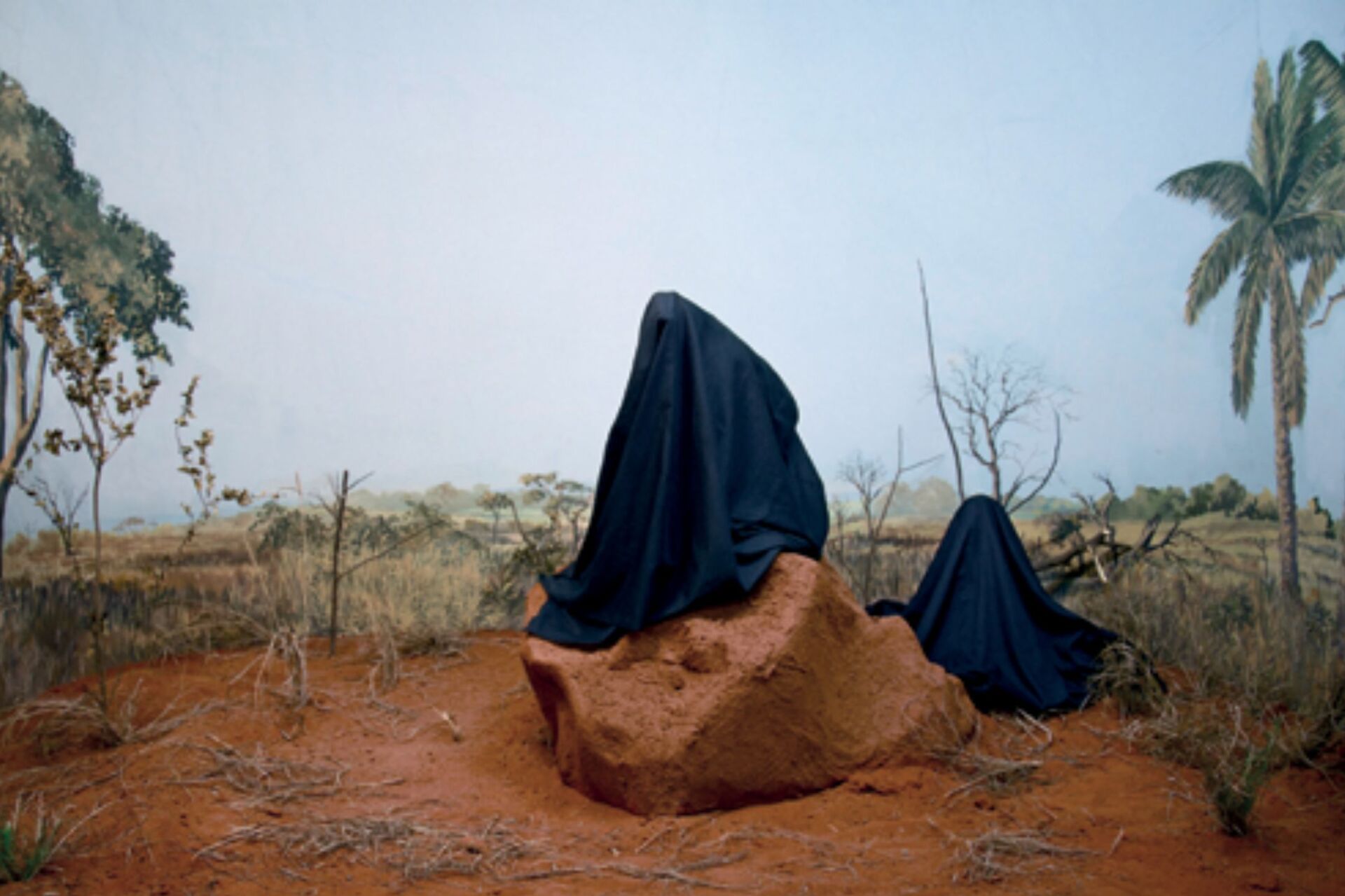Kiluanji Kia Henda
Staring into The Sun and Back
The nuanced work of Angolan artist Kiluanji Kia Henda addresses the hopes of decolonizing Angola, Angola under socialism as well as the country’s present day, looking out to its possible futures—both global and retrospective ones. His approach could be described as Afro-Retro-Futurism.
As presented at exhibitions, the installation Icarus 13: The First Journey to the Sun, that Kiluanji Kia Henda created in 2007, consists of 8 photographs, a tiny scale model of a spacecraft, and an accompanying commentary explaining about the first Angolan mission to the Sun. It sparks off an interplay between fact and fiction: what we (appear to) see, and what (we think) we know. A cinema, never finished after decolonization, used as public toilets today, represents an astronomical observatory. The mausoleum of the first Angolan president Agostinho Neto, the construction of which was started by the Soviets in 1982 and completed only thirty years later, is reminiscent of a Brutalist-futurist space rocket. The green rays of a lightshow over a football stadium during the celebrations of Angola’s team qualifying for the 2006 World Cup evoke the glow of igniting engines over a launch-pad.
Whereas according to philosopher Boris Groys the post-colonial subject arrives in the present time from the past, the post-socialist subject arrives from the future,1 at least if we decide to take in earnest the historical attempt to attain the utopian horizons of Communism. Both aspects are present in the history of decolonized countries, which—like Angola—had aspired to their version of socialist modernity during the Cold War, a modernity that cannot be excluded from the global context. At this junction we should therefore call to mind the statement of art theorist Kodwo Eshun who urges us to think in terms of “counter-futures” as well as countermemory.2 At the same time, the future against which we must work does not lie only in the oppressive ideology of progress, but also in the instrumentalization of the future as inherent in the technocratic and political rationality of strategic planning, which in the period following the Second World War became a major device of social control. As Eshun points out, Africa too thus becomes an “object of futurist projection”, where “African social reality is overdetermined by intimidating global scenarios, doomsday economic projections, weather predictions, medical reports on AIDS and life-expectancy forecasts, all of which predict decades of immiserization.”3 According to the adherents of Afrofuturism, the sci-fi imagination presents a possible answer to the strategic scenarios of those in power. In the African context, it also at the same time testifies to the colonial as well as post-colonial experience, the tumultuous and often controversial modernization, to both traditional and hybrid cosmologies.
While in Eshun’s reading of the Afrodiasporic sonic futurism 1980s technologies (synthetizers, samplers, softwares) function as means of tactical suppression of the racial connotations of a specific sound, Kia Henda works with a different, less obvious but all the more widespread cultural practice whose history also has its colonial and post-colonial aspects, namely documentary photography. The objectiveness one tends to associate with the documentary manner of representation here turns against itself. The documentary transparency of the image casts an oblique light on the story of the Angolan space program. Alluding to his formative experience of South African war photo-journalism, Kia Henda defines photography as the “weapon of intervention and denunciation”, but at the same time he admits that “sensationalism, omission or disorientation can be good tools when used in the artistic context”.4 He thus shows the places of memory as places of projection, where the past meets with the future, where the real overlaps with the potential. In doing so it exposes the current state of affairs as something that is far from natural, setting into motion the Afro-retro-futurist imagination. Thus in Icarus 13, the Mausoleum that functions as a sort of time-machine, the sports stadium as a vehicle of collective passions, and the cinema-cum-public toilets which metabolize the psychomotoric or excretive processes, become not only the means of extraterrestrial travel, but above all the mediums of the imagination.
1 Boris Groys, “Back from the Future”, Third Text, 17:4, 2003, 323–331.
2 Kodwo Eshun, “Further Considerations on Afrofuturism”, CR The New Centennial Review, vol. 2, June 2003, 287–302.
3 Ibid.
4 Ibid.
KILUANJI KIA HENDA lives and works in Luanda, Angola, and in Lisbon, Portugal. He is engaged in exploring the history of colonization and modernity using the medium of photography, video and performance. His work has been presented at a number of international exhibitions.
VOJTĚCH MÄRC is an art historian attached to the Academy of Arts, Architecture and Design in Prague. In his post-graduate studies he is pursuing the chemization of culture.








#36 new utopias
Archive
- #45 hypertension
- #44 empathy
- #43 collecting
- #42 food
- #41 postdigital photography
- #40 earthlings
- #39 delight, pain
- #38 death, when you think about it
- #37 uneven ground
- #36 new utopias
- #35 living with humans
- #34 archaeology of euphoria
- #33 investigation
- #32 Non-work
- #31 Body
- #30 Eye In The Sky
- #29 Contemplation
- #28 Cultura / Natura
- #27 Cars
- #26 Documentary Strategies
- #25 Popular Music
- #24 Seeing Is Believing
- #23 Artificial Worlds
- #22 Image and Text
- #21 On Photography
- #20 Public Art
- #19 Film
- #18 80'
- #17 Amateur Photography
- #16 Photography and Painting
- #15 Prague
- #14 Commerce
- #13 Family
- #12 Reconstruction
- #11 Performance
- #10 Eroticon
- #9 Architecture
- #8 Landscape
- #7 New Staged Photography
- #6 The Recycle Image
- #5 Borders Of Documentary
- #4 Intimacy
- #3 Transforming Of Symbol
- #2 Collective Authorship
- #1 Face
